Abstract
Calligraphy is a historical term that still has an elegant value in our modern society. Calligraphy was extensively engaged by the Greek artists as a sense of ornamentally displaying an expression. In present- day, Calligraphy In-script has been a fundamental aspect of Islamic and Chinese art, as it is applied in most of their creative work. Calligraphy In- script in Islamic culture has been varied in the sense that it has been instrumental in shaping the Quran, mosques and palaces. The most intriguing feature is how calligraphy has been applied in tuning letters in the Quran by embracing the Arabic language. In this sense, the Calligraphic practice of writing was used because the Arabs viewed it as a style of aesthetic and thus it simplified memorizing the Quran (Schimmel, 1970). With evolving times, Arabs generations have been able to come up with designs of calligraphy, which has resulted in varying decorations to enhance the beauty.
Chinese calligraphy is another historical form of art. It was suggestive of conveying thought and beauty (Grube & George, 1978). It draws similarities with other forms of calligraphy in society such as Islam. The calligraphy was employed in religion, keeping records of events that typically occurred during the Shang dynasty (Grube & George, 1978). Over time, the technique found its place in building architectures and other aesthetic dimensions in society. The calligraphic design has evolved to encompass; Qur’an verses, script, metalwork, tiles, coins and poetry verses. In this sense, it has been seen to connect the Islam religion directly with the individual Muslim language (Saeed, 2006). Qur’an continues to play a key role in developing Arabic as a language. However, standardized and average writing tools have not been instituted for decorative calligraphy since the use of hand-copying wording is still broadly employed.
Introduction
Calligraphy is designated as a kind of visual art. It encompasses the aspects of ornamental lettering. Present-day calligraphy endures to curl in forms of wedding and event invites, lettering design, logo design, and religious art, broadcasts designs, cut stone engravings and monument documents (Schimmel, 1970). Additionally, they are used in poignant images in films and televisions, maps and other works involving writing.
This paper gives a brief account of calligraphy by embracing Islam History and the Quran. The paper also explores the historical Islamic and Chinese calligraphy, during the Timurid period. Further, the paper explores how calligraphy played an important role in shaping mosques and Madrasa. It singles out Ding Xian mosque which Calligraphy has played a significant role in shaping. Finally, this paper explores the similarities and differences between Chinese and Islamic.
History of Islamic Calligraphy
Arabic language, Islam and religion, have been cited as the contributory factor to the rise of Islamic calligraphy. This is because calligraphy was strongly ingrained in Arabic letters it is often called Arabic calligraphy; however, the Islamic calligraphy fits the context as it involves all works of calligraphy done by Arabs calligraphers in China and Morocco, considered as basis point of calligraphy influence (Saeed, 2006).
Islamic Calligraphy is connected with symmetry existing on ceilings, mosques and walls. Present-day Islamic artists draw on the tradition of calligraphy to employ calligraphic engravings or ideas. Islamic art comprises the work of visual arts developed by communities that lived among the ancient non- Muslim and Muslim eras. These communities which practiced Islamic art constituted of both Muslims and non-Muslims origins. According to Safadi (1979), Islamic calligraphy constitutes a variety of art forms, which includes calligraphy, architecture, ceramic art, friezes, manuscript illumination, textile design, gold smothery, painting, architectural decoration and many others. Islamic art is a combination of art fundamentals from early Christians, Greeks, china cultures, Middle East cultures and the India cultures (Safadi, 1979).
The Greek architects were the designers of the early buildings in the Islamic empire. The buildings having being the works of the Greek architects, they resembled the buildings in the late Roman Empire. Due to the fact that they were building the mosques, unlike the churches, the Greek architects saw the need to try out some new designs. This contributed to the rise of different models of Islamic style. According to Safadi (1979, p.125), the Greek architects constructed the first mosque in Jerusalem. They referred to this mosque as “Dome of the Rock”. It is octagonal-shaped and very similar to the Hadrian’s Pantheon (Grube & George, 1978). In North Africa, the new Arab rulers constructed numerous great mosques in such places as Cordoba in Spain and in Tunisia.
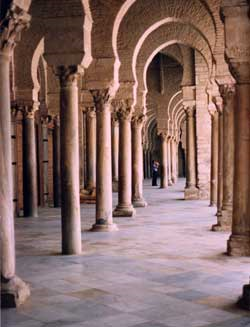
In Baghdad, the caliph’s architects constructed numerous mosques and palaces. The structural designs of the mosques in Baghdad were different from the one built by the Greek architects. The structural designs in Baghdad emulated Sassanian architectural traditions due to the fact Baghdad was in the Sassanian Empire (Saeed, 2006).
Free and easy movement of people within the Islamic empire contributed to the spread of calligraphy to other regions (Safadi, 1979). This enabled the architects to connect and share knowledge on different construction styles. The kings in these empires appreciated the value brought about by calligraphic architecture in; palaces and mosques. For instance, the Al-Azhar mosque in Cairo Egypt was built by the Fatimid’s in the 900’s AD while the Almohads of Spain constructed their palace at Granada, the Alhambra, in the late 1200’s AD (Meinecke, 1996).
The influences of Islamic Architecture
According to Meinecke (1996), the Islamic systems of architectures were mirrored to byzantine and Sassanid models. The effects of these models inspired the architects of the time hence it contributed to building of similar models such as the; dome of the rock in Jerusalem. The dome of the rock is adorned with arabesque patterns and the great epigraphic frieze (Meinecke, 1996). In other Arab countries like Jordan and Syria, palaces build in the desert were embraced by the caliphs as response halls, baths and living quarters.
Architectural concepts and plans were enhanced by embracing the advice of civic and religious leaders. This was to strengthen the diversity and anchor a religious philosophy which was a characteristic at this age. Buildings such as Umayyad mosque acted as a benchmark for builders and historians for their future work (Meinecke, 1996).
The holy book of Qur’an is written in Arabic thus the Arabs played a vital role in the Islamic art. Most of the wording in the works of the Arabs is portrayed in symbols and signs due to their interests in astronomy and mathematics. The Arabs had also inherited some knowledge from the Romans which made them eloquent in calligraphic in-script (Saeed, 2006).
The Turkish dynasties ruled a vast area of the Islamic empire for a long period of time. This rule can be directly linked to their spread of the Islamic art (Grube & George, 1978, p.208). The Turkish applied several ideas of art work which they learned while they were on their long journey to Egypt. The Turkish dynasty embraced figurative and non-figurative art designs which they had acquired from Asia. Most of the modern Islamic art works adorn a thought, tradition and taste of the Turkish influence and origin (Meinecke, 1996).


Quran
According to Haleem (2005), Quran was a symbolic representation of the heavenly mercy according to the Islamic religion. Muslims accords the Qur’an greatest respect because of the holy teachings of its contents). The artistic style employed in writing the Qur’an was unique thus even the presumptuous makkan society failed to understand (Haleem, 2005. The makkan society were fluent in the language and were very distinctive thus the objects of applause from all. The Qur’an was palpable, and any individual who felt dissatisfied with any chapter in the Qur’an was permitted to replace it, but no one ever succeeded (Nasr, 1987).
The message of Prophet Muhammad’s anchored in the Qur’an is the basis of emotional esteem and cognitive ability (Haleem, 2005). It has endeavored to preserve the honor of Qur’an. Hence, the purity has given rise to two expansions; which are; circulation of books as the background of knowledge, and o the expression of the characters in the Qur’an in a situation in which the holiness status of the book is outstanding. Therefore, a major conclusion is that the Qur’an devoutness is the rationale mark of all types of writing, which is the fundamental of all holy symbols (Haleem, 2005). This expansion had a significant and straight effect on the application of the holy characters of the book to the holy characters in the mosque surfaces.
A Series of Arabic verses with beautiful calligraphic art in the Quran:

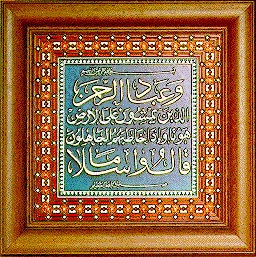
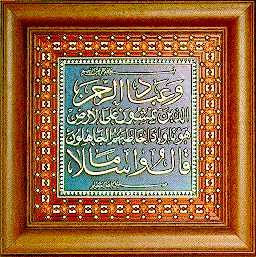
Qur’an and Calligraphy in Mosque
Typically, the Quran encompassed the Illumination and calligraphy, whereas ornamentation calligraphic inscriptions and inscriptions are associated with the mosque’s architecture’s. According to Nasr (1987), with the emergence of Islam, a novelty religious and secular architecture came into existence which covered southern Spain, North Africa and western Asia. The mosque advanced to a well-established pattern with spatial structure such as surface ornamentation, mimbar, mihrab and the calligraphic inscriptions. The prayer was outlined clearly by the Qur’an although the characteristics of the mosque were not specified clearly (Haleem, 2005). The medina mosque was where prayers were led by the prophets until the time when spatial necessities such as the mihrab were needed. Mosque architecture rose through the Umayyad control which saw the onset of architectural work of art. The project managers and engineers tried in vain to outdo the ideas in decoration, and calligraphic inscriptions but, the quality and productivity levels were immense.

Timurid Calligraphy
According to Ruggles (2011), Timurid calligraphy was widely in practice during this period. The art grew stronger after the birth of Timur. This was because, Timur grew up to be a great conqueror and at the age of 31 years old, he conquered Mongol dynasty thus, becoming the ruler of Samarkand. This magnificent success gave rise to the Timurid Empire, an Islamic empire (Gruber, 2010). The Timurid Empire was a predecessor of the Mughal Empire. The mosques in Yezd and Kernan were typical to those in the Timurid. The Timurid was known for distinguished painting schools in places such as the Herat and Shiraz. In book binding and the Islamic arts of calligraphy, Herat had a variety of wonderful painted manuscripts (Ruggles, 2011). The Timurid art was viewed as a modification of the basic elements of the Islamic art in the east.
In the Persian culture, Shah-i-Zinda stands out for the reigning king and in central Asia; it is the commonly recognized necropolis. The necropolis constitutes of some ritual buildings and a mausoleum. Ruggles (2011) explore that Timur constructed Shah-i-Zinda based on the sacred legend that Prophet Muhammad’s cousin was beheaded on that ground while preaching Islam. A variety of the Ilkhanid’s decoration was made up of a combination gold, blue and white tile work. Gur-e-Amir stands for the king’s tomb according to the Persian culture. It stands out as the benchmark model for the Mughal architectures. The Gur-e-Amir was grand thus; it was considered as the essence of the imperial style in the most parts of central Asia. The construction project was engineered by a Persian architect known as Muhammad-bin- mahmudisfahani (Ruggles, 2011).
The following is a series of the Timurid architectural arts:
The figure below shows a decorated mausoleum, Timurid necropolis and the portal of shah-i-zinda
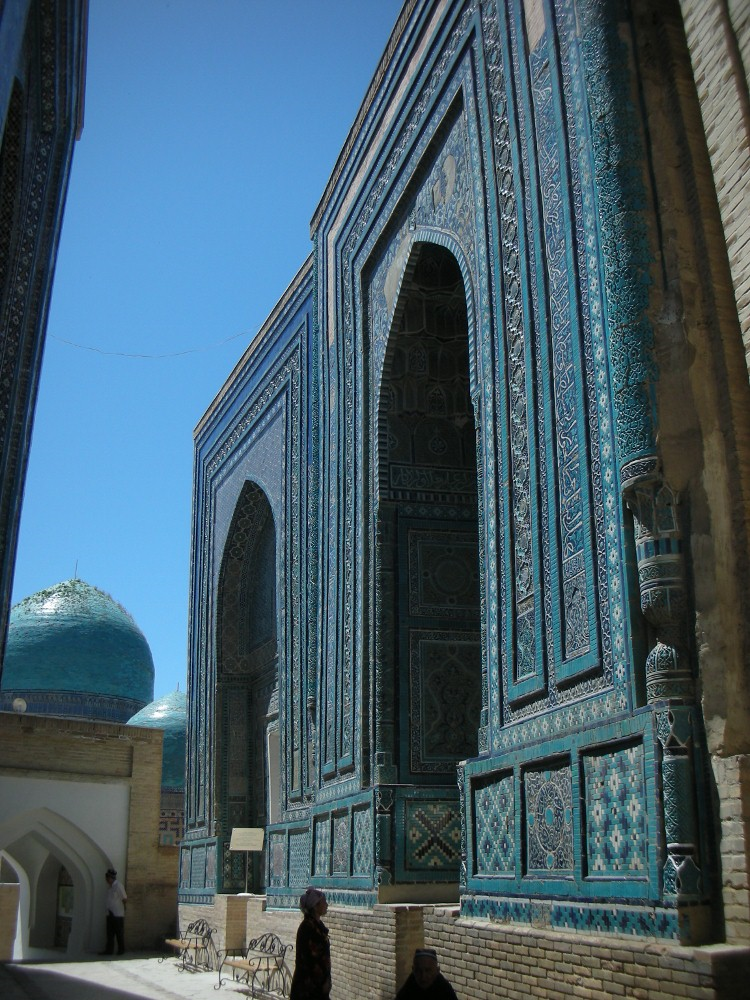
The figure below shows Ilkhanid rosette on the interior and exterior of necropolis
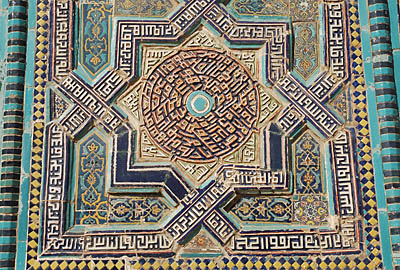
A variety of the Ilkhanid’s decoration was made up of a combination gold, blue and white tile work.
The images below depicts the ceiling and the interior design of the Gur-e-Amir dome
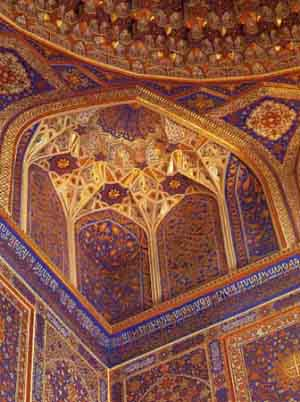
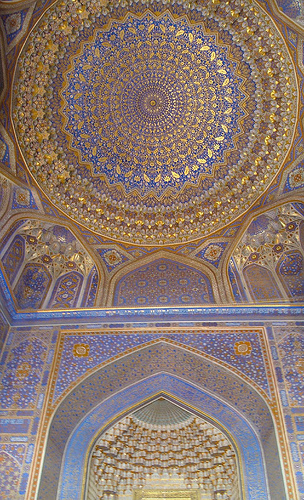
The image below shows the exterior front portal of the Gur-e-Amir
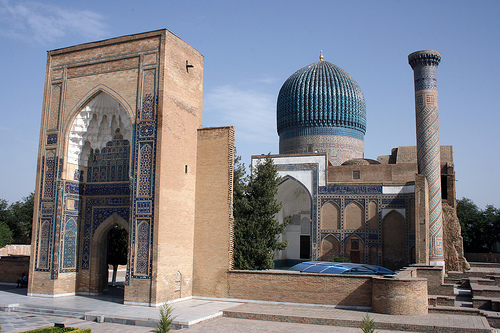
In the beginning of the year 1400, Timur started a major construction of the Bibi Khanym Mosque. It was a very huge mosque, took 4 years to complete and the construction work involved architects and artists from throughout central Asia. The mosque got its name from the wife of Timur. The inscriptions of Bibi Khanym Mosque were made out of patterns made from the mosaic tile work (Safadi, 1979). The mosque entire mosque structure was constructed using precious stones.
The picture below is an exterior structure of the Bibi Khanym mosque
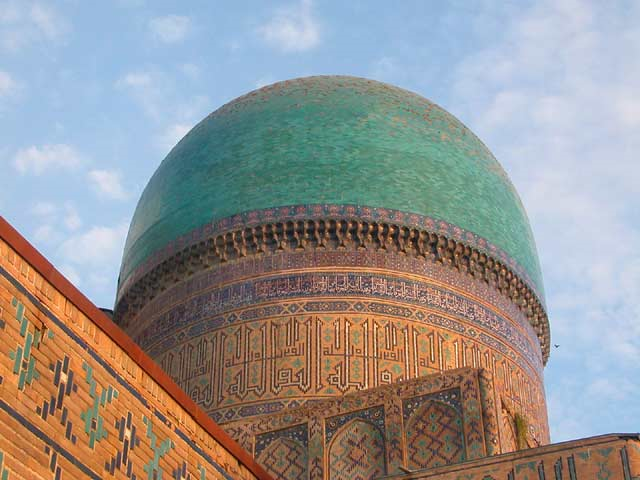
Calligraphy Art in Mosques and Madrasa
The Islam developed unique styles, which camouflaged walls, of mosque and madrasa’s. The principle involved the application of infinite patterns on the surfaces of any medium. The final art work was a superimposed element which tricked the eye into an illusion of the image. The illusive aspect was enhanced by the use of decorative works. Tiles and plaster decorations were used to cover up solid walls of Mosques and Madrasa while arches and vaults were camouflaged with epigraphic and floral decorations. Infinite patterns of radiating designs were put into dome which reduces the solidity of masonry and stone. This art made the stones to appear in a crystallized form.
The figure below depicts the frontal exterior portal of the Sher-Dor madrasa.
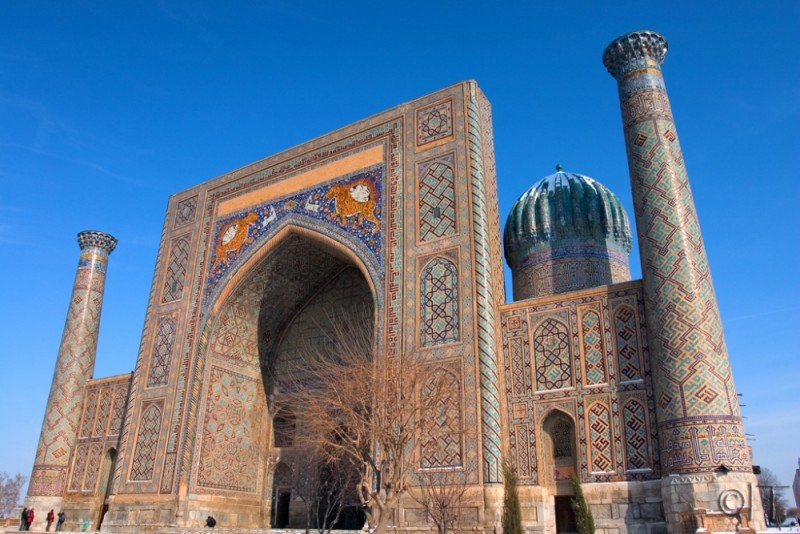
Sher-Dor is a Persian word which can be translated to mean ‘having tigers’. In the figure above, two tigers can be clearly seen from the front part of the entrance to the madrasa.
Islamic Architecture in China
According to Abe (2010), Islam made its entry in China during the 7th century. Thus, the entry of Islam has left a tangible mark in Chinese civilization, which in years, has shared close similarities with other cultures such as Indonesia. Abe (2010) explored the link existing China and Islamic culture; he described Islamic contribution to the country in terms of Islamic heritage in China. According to Abe (2010) one of the significant contributions of Islam in China is the building architecture as it can be seen in calligraphy and ornaments. Rosten (2005, p.125) explores that Islam present in China was first felt as a result of building the first mosque in the seventh century. This period coincided with the Tang dynasty hence it is interesting to note that, the first mosque constructed depicted traditional Chinese architecture.
The Chinese are well versed with Islamic calligraphy, which they called Sini. Popularity of Sini is traced in the mosque in Eastern part of China. Chinese Calligraphy gained much popularity during China’s reform era, thus; one can notice such calligraphy crafted with philosophical substances, on walls of homes, plagues and mosques. Moreover, such contents can be found in weddings, birthdays, greetings and condolences messages (Chiang, 1973, p. 69). Historical records indicate that the Chinese employed pictures to communicate which in turn lead to developments of lines, symbols to suggest the item that was referred to. The symbols and lines have played a basis to what is known presently as the Mandarin language. In calligraphy, the art of lettering was ultimately enriched.
Calligraphy received reputable position in the eyes of Chinese society. Perhaps, this is the reason as to why calligraphic silk scrolls are often witnessed in most Chinese architectures (Abe, 2010). Besides, the Muslims communities in china have greatly contributed to the enrichment of the china landscape. Thus, they have created Islam Chinese fusion of calligraphy. This has been witnessed through the construction of numerous mosques and the introduction of Islamic architecture in china. This encouraged the continuation and preservation of the Islamic culture and religion in china. According to Features (2006) the presence of the great mosque in Xi’an city indicates the existence of the Muslim religion in china. This encourages Muslims to become permanent and temporary residents of china. There are several Islamic architectures in Xi’an city, which includes; the mausoleum of Qin Shihuangdi, emperor Tang Taizong tomb and the terracotta army (Features, 2006). Xi’an city is also a permanent residential place for some smaller Asian ethnic group. Muslims population entered china during the era of the Tang, and they settled in trading centers and port cities which were essential, for business activities.
The great mosque in Xi’an is a fountain of religious benefits to the Muslim residents. The structure of the great mosque comprises of a combination of Islamic elements and the ancient Chinese architecture. The mosque stood strong despite China’s harsh Cultural Revolution which witnessed the destruction of numerous buildings (Chiang, 1973).
Ding Xian mosque, China
Ding Xian mosque is one of the major and well conserved historical mosques in China. The Mosque was constructed during the Ming Dynasty. This period was characterized by fusion of Chinese architectural features into mosque structural design. Like other leading Mosque such as the Guangzhou and Hangzhou, Ding Xian Mosque is believed to exist during the seventh century (Digital Library, 2011).
Xian mosque occupies an area of about 48 x 248 meters. The walls enclose a surface area of twelve thousands square meters. In contrast to most Chinese Mosques, Xian mosque depicts the layout of traditional Chinese temple. On its single axis, courtyard is decorated with pavilions and pagodas; this is to cultivate Islamic meaning. Moreover, the grand axis of Xian is linked from east to west, thus facing Mecca. The interesting feature of the Great Mosque is that, it is made up of five sequential courtyards; each is composed of a screen gateway, pavilion, and a lead to a prayer hall situated at the west side of the axis (Digital Library, 2011). The entrance of one of the five courtyards is done using two gates located in the North and South of confines walls. On the Eastern part, the boundary wall has been built using beautiful grounds and elegant bricks. Besides, it is engraved with flowery decorations, ordered into three equilateral forms.
Xian mosque has rooms on the northern walls. These rooms have amazing fronts with “a strong pavilion” at the center. Pavilion being used as a lecture hall is made up of three havens which are wide and has a hipped ridge; it is moreover abutted with an outcrop at the center.
The second courtyard is detached from the first one by a narrow pavilion. The narrow pavilion is made up of uncurving stone, known as pailou which has been built to depict a wooden edifice (Digital Library, 2011). It is also made up of three entrances; the main is broad and higher than the two. All the three entrances have engravings. Besides, the second courtyard has a unconnected perpendicular brick berths, engraved with sumptuous flowery themes and capped with smooth tiles. These decorations are repeated in the third court yards, and are further strengthened with Arabic engravings, and stone tablets located at the periphery.
The fourth courtyard has three main entrances. They are made of wooden doors decorated with marbles. The roofline links three dissimilar pavilions thus extending from the main central hexagonal configuration towards the pyramidal ceiled marquees. The prayer Hall, which is a central layout, is made up of a porch and an extended hall. It has a prominent gibla bay; these three sections cover an area of about 1,270 meters (Digital Library, 2011).




Differences and similarities between the calligraphy in-scripts in the Chinese and the Muslims religions
The major difference between the Chinese and the Muslim Calligraphy can be denoted in the physical appearance of the in-scripts. The in-scripts in the Chinese characters appear enticing to the eye since they are very neatly done in a square form. The majority of the Chinese houses and temples are designed in a symmetrical square matrix. The Chinese are used to reading words which are usually boxed in a square. The Chinese calligraphy tends to overestimate the deft strokes of sini scripts and the curves (Saeed, 2006). Contrary to the Arabic mosques in which the placards appears in flowing Sini script. The features in the Chinese calligraphy employ a variety of calligraphic styles, and the net weight is always placed in cases of single characters of the single down stroke style. The calligraphy in Arabic is sometimes boxed in a rectangle. The names of the prophet or God are usually wrapped on the outside of the border of the rectangular frame.
Islamic writings have which have flowing tails this is in contrast with the Chinese lettering which are crafted in a square form. The writings illustrate their architectural flair of consistency and square buildings. Although a slight difference exists between the Islam Calligraphy and the Chinese, they have common features. One of the universal similarities is the use of flowing Sini Scripts. Both Chinese and Islam use the flowing Sini scripts in their artistic works. Chinese hangs the works written by flowing scripts such as odes scripts in the entrance of their temples and houses. Also, they both utilize the use of flowing Sini Scripts signs with Arabic writings. These are commonly found in entrances in mosques and temples. The Sini scripts are encircled in a square or diamond like squares which symbolizes of success.
Also, another similarity is the rectangular calligraphy feature with the name of God vertically extended. This is common in Arabic Calligraphy. Also, Sini script is used to represent objects and is referred to as calligraphic art (Nasr, 1987). Objects are used to represent words in this form of art. Sini scripts are known to depict a rich mixture of iconographical and pictorial ideas in both Islam and Chinese culture.
Lastly, both Chinese and the Islamic calligraphy use hard parchments to lay down their arts despite the existence of fine paper. This practice ensures the art made is not damaged as a result of hard surface or in other unforeseen circumstances.
Conclusion
As we have seen, the art of calligraphy has contributed to shaping history of Islam and Chinese in various aspects. For example, Islamic architecture derived its style from the foundation of Islam and shows a wide range of both religious and secular styles. These styles have been expressed in different edifices and buildings thus representing the unique Islamic culture. Calligraphic decorations have played a part in ornamenting mosques, palaces tombs and forts. Besides, the practice has ingrained in present society in terms of beautifying wedding cards, announcements and animation in moving pictures seen in films and TVs.
This paper has explored the history of Islam calligraphy and its influence. The paper has also looked into Quran, and how Quran influenced the use of calligraphy in Islam and it place in Mosques. Also, the paper has explored the calligraphy during the Timurid period. This period influenced the use of art in schools, mosques and in places among other places. In addition, the paper has addressed calligraphy in mosques and madras. Chinese calligraphy emerged as a result of interaction with Islam culture. The paper has also explored the influence of calligraphy on architectures in China, and the art of In-script in shaping the Ding Xian mosque. Lastly, the paper has compared and contrasted Islam and Chinese calligraphy.
References
Abe, B., 2010. Chinese Calligraphy Imparts Wisdom. Web.
Artyom, B., 2011. Central Mosque, Almaty, Kazakhstan. Web.
Chiang, Y., 1973. Chinese Calligraphy: An Introduction to Its Aesthetic and Technique, Harvard University Press, Massachusetts
Digital Library, 2011. Great Mosque of Xi’an. Web.
Features, 2006. Islamic Calligraphy in China. Web.
Gruber, C., J., 2010. The Islamic Manuscript Tradition: Ten Centuries 0f Book Arts In Indiana University Collection. Indiana University Press, Indiana.
Grube, E., J., and George, M., 1978. Architecture of the Islamic World: Its History and Social Meaning, With a Complete Survey of Key Monuments, Morrow, Michigan.
Haleem, M., A., 2005. The Qur’an. Oxford University Press, Oxford.
Islam101, 2011. Arabic Calligraphy of the Holy Quran.
Meinecke, M., 1996. Patterns of Stylistic Changes in Islamic Architecture: Local Traditions Versus Migrating Artists, NYU Press, New York.
Nasr, S., H., 1987. Islamic Art and Spirituality, SUNY Press, New York.
Rosten, K., 2005. Once In Kazakhstan: The Snow Leopard Emerges. iUniverse, Nebraska.
Ruggles, D., F., 2011. Islamic Art and Visual Culture: An Anthology of Sources John Wiley and Sons, New York.
Safadi, Y., H., 1979. Islamic calligraphy, Shambhala, Massachusetts.
Saeed, A., 2006. Islamic thought: an introduction. Taylor & Francis. London.
Schimmel, A., 1970. Islamic calligraphy, Brill Archive, Leiden.